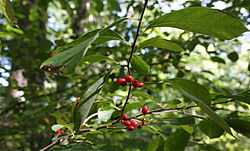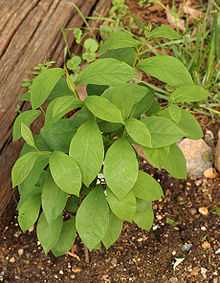Lindera benzoin
| Lindera benzoin | |
|---|---|
.jpg) | |
| Scientific classification | |
| Kingdom: | Plantae |
| (unranked): | Angiosperms |
| (unranked): | Magnoliids |
| Order: | Laurales |
| Family: | Lauraceae |
| Genus: | Lindera |
| Species: | L. benzoin |
| Binomial name | |
| Lindera benzoin L. | |
| Synonyms | |
|
Benzoin aestivale | |
Lindera benzoin (wild allspice,[1] spicebush,[2] common spicebush,[3] northern spicebush[4] or Benjamin bush[2]) is a flowering plant in the family Lauraceae, native to eastern North America, ranging from New York to Ontario in the north, and to Kansas, Texas, and northern Florida in the center and south.
Characteristics
Spicebush is a medium-sized deciduous shrub growing to 5 m tall, typically found only in the understory of moist thickets. The leaves are alternate, simple, 6–15 cm long and 2–6 cm broad, oval or obovate and broadest beyond the middle of the leaf. They are very aromatic when crushed, hence the common names and the specific epithet benzoin. The flowers grow in showy yellow clusters that appear in early spring, before the leaves begin to grow. The fruit is a berrylike red drupe, rich in lipid, about 1 cm long and is highly prized by birds. It has a "turpentine-like" taste and aromatic scent, and contains a large seed. Spicebush is dioecious (plants are either male or female), so that both sexes are needed in the garden if one wants berries with viable seed. The leaves, buds, and new growth twigs can also be made into a tea.

Spicebush is a favorite food plant of two lepidopterous insects: the spicebush swallowtail Papilio troilus, and the promethea silkmoth, Callosamia promethea. The larvae of the spicebush swallowtail are easily found inside leaves that have been folded over by the application of silk; small larvae are brown, resembling bird droppings, and mature larvae are green, with eyespots resembling the head of a snake. Since several broods (generations) of spicebush swallowtails typically occur each year, spicebush is a useful plant for the butterfly garden, since the egg-laying females are strongly attracted to it. Promethea moth cocoons, if present, can be found in the winter, resembling dead leaves still hanging from the twigs. Neither of these insects is ever present in sufficient quantities to defoliate a spicebush of medium to large size, although very small specimens may suffer even from a single caterpillar.

Related or potentially confused species
Other species in the Lindera genus also have common names containing the word "spicebush". Calycanthus (sweetshrub, spicebush) is in a different family within the Laurales.
References
- ↑ USDA, ARS, National Genetic Resources Program. Germplasm Resources Information Network (GRIN - Online Database). National Germplasm Resources Laboratory, Beltsville, Maryland. (24 July 2013)
- ↑ 2.0 2.1 Flora of North America: Lindera benzoin
- ↑ Peterson, Lee Allen (1977). Edible Wild Plants. Houghton Mifflin Company. p. 208.
- ↑ Lindera benzoin at USDA PLANTS
External links
| Wikispecies has information related to: Lindera benzoin |